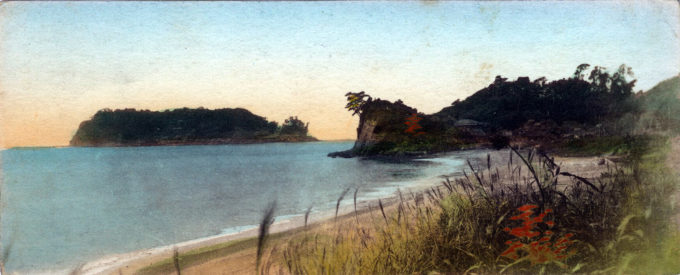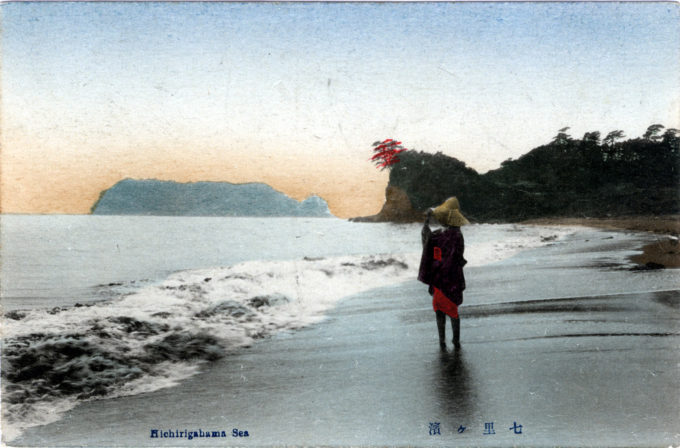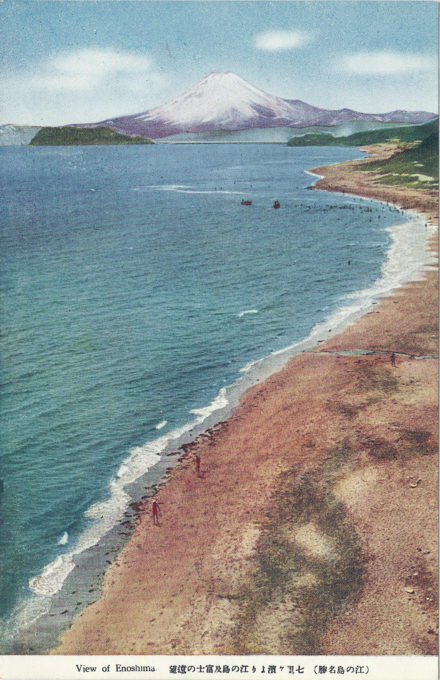
Enoshima from Shichirigahama [“Seven league beach”], c. 1910. At center, with the pine tree overhanging the beach, is Koyutugimisaki [“Small movement cape”]. The beach also figures in the story of six young students who, in 1908, drowned in a boating accident (see details below).
“Whole View of Yenoshima” from Katase, c. 1910.
Yuigahama Beach, Kamakura, c. 1910.
“Shichirigahama is a beach near Kamakura, Kanagawa Prefecture, Japan, which goes from Koyurigimisaki Cape, near Fujisawa, to Inamuragasaki Cape, west of Kamakura. Since from it one could enjoy a clear view of both Mount Fuji and Enoshima at the same time, during the Edo period it was popular as a subject for ukiyo-e.
“Its name is usually translated into English as ‘Seven Ri Beach’, the ri being a unit of measurement. Its dark sands are rich in iron ore which allowed Kamakura to become a florid center for the production of swords and knives. Unlike its easterly neighbor Yuigahama, its floor drops too quickly, so it is not very popular as a sea resort.
“At the western end of the beach another cape, similar in size and shape to Inamuragasaki, juts into the sea. It’s called Koyurugimisaki (‘Small Movement Cape’). The origin of its unusual name is unknown. But, one legend says that, during the Edo period, on it stood a pine tree which shook even when there was no wind, producing an extremely pleasant sound as if a celestial creature was playing an instrument. According to another, the founder of the shrine, who was a Kamakura period samurai called Sasaki Moritsuna, saw the pine tree move very slightly and emit sounds like those of a koto, so he gave the cape its name.”
– Wikipedia

Sea bather standing in the early morning light on Shichirigahama Beach, Koyurugimisaki (with the pine tree), & Enoshima in the distance, c. 1910.
The white peak of Fuji, the green isle of Enoshima
Gazing upon them we now shed tears
To the brave souls of the boys who died at twelve
We will dedicate our hearts and minds.“This song is known by everyone. When we hear it, we all envision them moving and pitiful story of the Shichirigahama Incident upon which the song is based. This incident involved six students from Zushi Junior High School who were drowned in a boat accident at Shichirigahama in January 1908 (Meiji 40). I had never given second thought to what had really happened in this incident until I read the Shichirigahama: One Man’s Fate by Miyauchi Kan’ya.
“At the time of the drownings, a Mr. Ishizuka, a teacher who had been the dormitory supervisor, resigned from his job to take responsibility for the incident … The novel was written by teacher’s son, as an attempt to elucidate the real nature of the events … [O]ne day when his father had been absent from the dormitory six unruly junior high school students had taken a boat out to sea, without permission, in order to hunt sea birds and enjoy a feast, and had drowned in an accident. As dormitory supervisor, Ishizuka was naturally held responsible. Since resignation of a supervisor to take responsibility for an accident is common enough even today, one can only suspect there was another reason why this incident became mythologized overnight as a revolutionary martyrdom.
“… To be more specific, it was the above-mentioned song, written by a teacher name Misumi Suzuko at the Kamakura Women’s Academy and sung at the funeral by female students (to the melody of the Protestant hymn ‘When We Go Home’) that suddenly transformed the nature of the incident and transferred it to a different level of meaning.
“What kind of social process was this, that mythologized and thoroughly aestheticized this instance of adolescent impetuosity and foolishness that might have occurred anywhere? Without necessarily intending to do so, Miyauchi Kan’ya’s interpretation uncovered a scandalous perversion that underlay the mythologizing of the incident. In his view, it was the puritanism an self-deception of Misumi Suzuko, who composed the lyrics of ‘The White Peak of Fuji,’ that lay at the root of this incident.
“Thirty-nine-year-old Suzuko had moved to Kamakura to be treated for tuberculosis and was working there as a teacher. In the interests of ‘improved health’ Suzuko hoped to marry. According to Miyauchi, she was obviously unaware of the extent of her self-deception in giving this rationale. The accident happened while the superintendent of the school, who was trying to arrange Suzuko’s marriage to the dormitory supervisor Ishizuka, detained the latter in Kamakura to discuss the matter.
“Although Ishizuka, ten years younger than Suzuko, had accepted the match, he was shunned by Suzuko after the incident. He resigned from his position and withdrew from public life, not only to take responsibility for the accident, but because he was overwhelmed by Suzuko’s rejection.”
– Origins of Modern Japanese Literature, by Kojin Karatani & Brett de Bary, 1993


